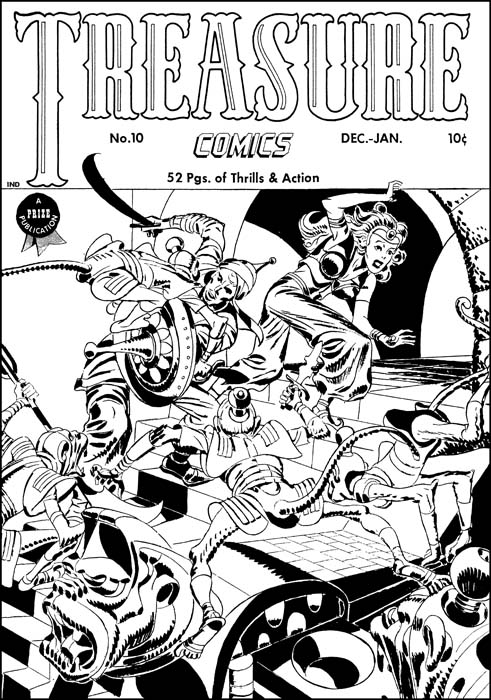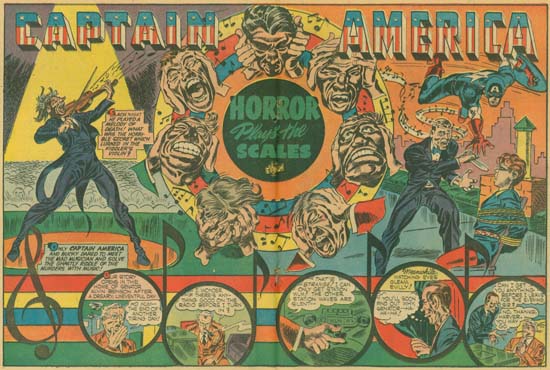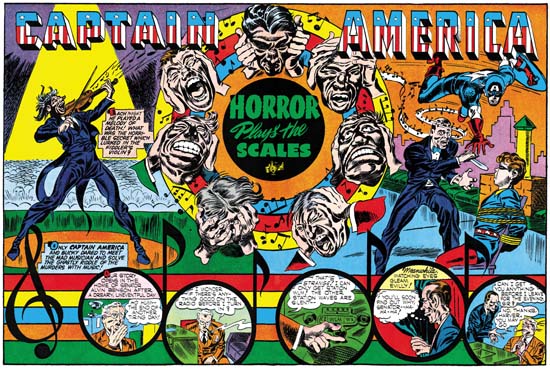Not long ago Daniel Best wrote a post on his blog about art recreations used in Marvel Masterworks (Original Art Stories: Marvel Masterworks Non-Original Artists). The gist of his comments was that he objected to Marvel’s use of recreated art in the Masterwork volumes. Mike Kelleher who does work for Marvel reprints posted a reply on the Marvel Masterworks Fan Site. The ensuing thread is typical of the sort of thing to be found in lists. It ranges from insightful discussion to meaningless name calling.
I have to give Mike Kelleher credit; he is open about what he has done. Apparently he felt quite justified in recreating art in some cases:
Marvel never gave me any instructions on how to recreate art. There is no way anyone could have known I redrew some of the pages on paper first before reconstructing them. My first 6-12 months of art recreation was done digitally, I then read an article somewhere ( might have been here but I don’t recall ) about how artists used to, and still do, literally redraw the pages for reprint purposes. Since I wasn’t happy with the results I was getting digitally, I decided to try drawing them (contrary to recent comments I am an accomplished, although unknown, artist :-). I’m still getting the feeling that some people are trying to attach sinister motives to this process, but there really are none.
He has an interesting post in the thread showing various stages in one of his reconstructions. Of particular interest to me was this statement:
Because Masterworks line art is printed 100% black just like the original comics, we need to digitally transform this image so that there is no grey. This is problem 1. There is no setting that will fill in the areas where the ink was light or dropped out completely. After playing with the adjustments for a few minutes I have decided that this is the best result I can get…
This explains the source of many of Marvel’s problems. Restricting the black plate to just line art was common in the original comics but is not typical of modern printing methods. In my opinion Marvels use of this technique in their reprints unnecessarily complicates the restoration process. With the level of correction that must be done the final results can be anything from a restoration to a recreation, depending on the person doing the work.
I found another of Mike Kelleher’s comments interesting:
Final points– All reconstructed artwork ( and most done from scans of stats and original art ) have some level of redrawn lines. Reality. Period.
This simply is wrong but I understand now why he believes it to be true. It is all back to that 100% black plate. Use a modern separation and you just cannot beat reproductions based on original art (assuming the original art is complete). I know original art is not always available so this is not a suggestion that Marvel take that approach.
In a previous thread on the same Marvel Masterworks Fan Site I learned from another that micro filch were used as the source for some of the golden age reprints. These micro filch were made many years ago but still occasionally show up in places like eBay. Their quality is fine for casual reading but as a source for reprints they leave much to be desired. Any reprint based on micro filch would almost certainly end up being a very poor recreation.

Treasure Comics #10 (December 1946), art by Jack Kirby
Years ago I decided digitally restore the line art for every Simon and Kirby cover. Even then I could not afford to chemically bleach the original comics. So I developed a method to remove the color using Photoshop. I must add that I am sure others have also figured how to do this on their own. Digitally bleaching is not as successful as with the use of chemicals so there was still a lot of work needed to clean up the final results.

Captain America #7 (October 1941), art by Jack Kirby (original scan)
Larger view
I did finish the project but in the end I came away with two basic realizations. One was this method required too much work. The second was that color really should be a part of the restoration process. I did not like Marvel reprints and felt there was a better and more accurate way of doing things. So once again I figured a process using Photoshop to do restoration. And yes I am sure others figured it out themselves as well. Usually I only post at least partially restored images in this blog, but now I will made an exception. The above image is an actually scan from a comic just as it came from my scanner. Below can be found my restoration based on that very scan. I was so pleased with my method that I once started a group (Digitizing Comic Books ). In that group I posted an explanation of some of my techniques. Well I do not think many got what I was trying to do so I never went past the basics. I am the moderator so there will be no problems if anyone wants to become a member. It is pretty much a dormant group but the archive still has my posts.

Captain America #7 (October 1941), art by Jack Kirby (restored)
Larger view
Is Marvel being dishonest by presenting recreations in a reprint volume? My original reaction was yes. Some on the thread have said that this was all well known facts. That it was not hidden in either Marvel interviews or posting on lists. I do not feel that is true discloser as not everyone reads those interviews or reads all comic book lists. So I pulled out my Marvel Masterwork volume of Daring Mystery. There in the table of contents they credit those who did the color and art “reconstruction”. Yes reconstruction is their word. My dictionary provides this definition of the word reconstruct:
“1) to construct again; rebuild; make over. 2) to build up, from remaining parts and other evidence, an image of what something was in its original and complete form”.
Well I feel the first definition is certainly valid for what Marvel has been doing (though not the second since the final result is nothing like the original form). So yes Marvel is being honest. I should have been more careful when buying these volumes because here reconstruct is another word for recreate.
There are those who honestly like Marvel’s approach and think the Masterwork volumes are the correct way to do reprints. They would not spend their money on what they would describe as just scans. There are also those who really are only interested in the characters and have little concern for studying the original artists and inkers. For all of them these Marvel Masterworks are a good deal. There are others who never did like what the glossy pages and flat colors of the Masterworks. There are also some who truly admire the earlier artists and want to see their art and not some recreation by a modern artist. For those the Masterworks just do not have the same value. I fall in this second category and I will be getting rid of the volumes I have and will not buy any more.


Very insightful and very well done Harry. As you would have seen, I gave up with that forum once it was reduced to name calling and petty insults, but as I understand it they’ve gone on with it and attempted to justify the new art in place of the old. You’ve shown that the art can be restored without being recreated. Well done.
Two minor comments from a rather disinterested party (I don’t own any of the Marvel Masterworks or other expensive comics reprints):
1) I assume by “micro filch,” you mean “microfiche”?
2) This is more a response to reading your comments on the Marvel Masterworks Fan Site: You’re a historian and a scholar. Historians and scholars recognize that they need, if at all possible, to go to primary sources to get the information they want – and when that’s not possible, that they must be cautious dealing with secondary sources. The Masterworks volumes, whatever their means of reproducing old comics, are clearly secondary sources, and in that sense, it seems to me unfair for you to have expected them to adequately serve your scholarly needs (such as understanding Joe Simon’s inking). But to be fair to you, you checked up on their adequacy (by comparing an original comic with the reproduction) and determined that it wasn’t adequate to your purposes. But those purposes, I think it’s correct to say, are quite different from the purposes of most purchasers of the Masterworks volumes.
Please don’t mistake that second comment for any criticism of your work. I greatly respect and enjoy what you present here on the blog: I’m always fascinated with identifying artistic styles; I’m a great lover of Simon’s “hay” – and where else do I get to see Kirby’s funny animal comics?
“O”
Yes microfiche (that will teach me to just write off a post).
I wish I could afford primary source for every comic book artist I find interesting. And sure I realize that is the way it should be done. But I am not convinced that most purchasers do not care about how the Masterworks are produced. Comics are both images and words and to say that for most the images are not important seems like a stretch. I wonder if what sales would be like on Masterworks if it was clearly stated that the art was recreated by modern artists. I doubt that it would sell anywhere nearly as well. When discussing this issue on the Marvel Masterworks Site I found I was not the only one who objected to Marvel’s recent approach.
Well… I must say, I am disappointed to read this. 🙁
I was thinking that the refurbishing was really done a 100% digitally, and that it was mostly digital enhancing of lines and filling in of bigger areas of black, but apparently it’s not.
I’ve done some fan-restoration myself, since my hobby is colouring and I love the old masters, and want to touch their work with my own colours. I can agree that sometimes what you have to work with, is so horrible that the results simply can’t convey all of the details in the original art. ( working with a 100+ year old Little Nemo page is a *bitch* believe me..)
I think, perhaps it’s better to just let the art look less detailed then, because that’s all there is left, and it will give a true look of the original printed art. Well… as true as anyone under the age of 55 will ever be able to see it.
( I’m 24 myself, and haven’t gotten the same chance as those older than me)
I’m a bit pissed about something else tho… and it’s one of the reasons why there is apparently a need for tracing the original art.. and that is the so-called “collectors” and “fans” that I have heard is sitting on original art, but never showing it to the world, or letting anyone but an extremely limited clientèle knowing that it exists, and that they have it.
If these so-called “fans” ever let the world know that they own the art, they do it trough a discreet message to Marvel, demanding a hefty little check for a simple scan…
That, my dear ladies and gentlemen, IS BULL-SHIT!! >:|
If they were real fans, they’d let the world know about this art, and they’d let Marvel have the art for a purely symbolic sum, or even, as I personally would most definitely do it, for FREE.
That, is the measure of a true fan, and not a bull-shitter.
Lars,
My current preference for restoration is to improve the scan as much as possible without the restorer adding his own touch. If that means that final result will not look like it was created yesterday, well so be it. As for original art owners not supplying scans unless they get a hefty fee? Well if that is truly going on then I agree with you it is a reprehensable action. I suspect that is infrequent. I have supplied Marvel with scans of orignal art and old comics without ever asking for compensation. I was happy to do so even though I never received a copy of the book. Although I disapprove of Marvel’s recreating art, if there was anyway I could help them in the future I would. Just because I do not like their approach is no reason to spoil it for those that do.
You sound like an upstanding guy Harry, and definitely the kind of guy I’d call a real fan. 🙂
Altho’ I’m disappointed that this is the way things are, I have to admit… I’m probably still going to keep buying some Masterworks. Mainly because there’s currently not a much better way to read these classics. The originals are too expensive, and illegal scans of them are in such a horrible condition, that it tears my eyes..
Still, I hope that now that you’re making the practice known, that Marvel will consider putting in more of an effort, in getting a hold of original art, to keep the tracing to a minimum.
And hey, there’s still a lot of the old Masterworks, right? The ones made in the late 80’s and 90’s, and those are have more original art, right?
Or do they…
By all means continue to buy Masterworks. You know the limitation of what you are getting and as you point out you are at least getting legal copies.
As far as Marvel changing their practices, I doubt that just disclosure will be enough. They do have a fan base and they do make money on those books. Perhaps if books using true restoration techniques take up more of the market, Marvel might then change.
My understanding is that all the reasons behind Marvel’s use of recreated art were already in place in the 80’s. By that point Marvel had already thrashed some valuable stats and all that was left of the original art had been returned to the artists.